A bathhouse with a swimming pool is one of the most popular projects in construction. Before starting work, you need to evaluate how much space can be allocated for it, what foundation will correspond to the soil. The pool is a complex engineering and hydraulic structure, which includes a complex of expensive equipment: filtration, pumping, heating, etc. Therefore, the construction of even a small pool, 3x5 m in size, will cost a potential owner a decent amount.
Advantages and disadvantages
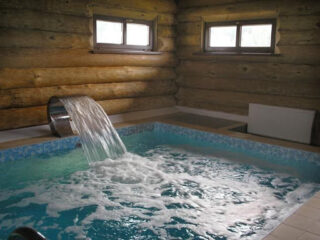
Relaxing in a bath with a swimming pool, a person experiences sensations of a higher level - after diving into cold water after a steam room, he receives a charge of energy that has a positive effect on the state of the cardiovascular and musculoskeletal systems.
It is much easier to build a bath complex if you initially provide for the presence of a reservoir and the installation of the necessary equipment in the project. This will be much more difficult in the future.
Due to a significant increase in humidity in the bath room, maintenance becomes more difficult, since it will be necessary to clean it much more often from microorganisms and various types of fungi, which multiply much faster in a humid environment. Special requirements apply to electrical safety and the operation of heating equipment. The facility has an extensive water supply and sewerage system operating in difficult climatic conditions.
Weaknesses are not pure weaknesses. These are rather the features of structures that must be taken into account at the stage of developing technical documentation and during the operation of facilities.
Determination of the construction site
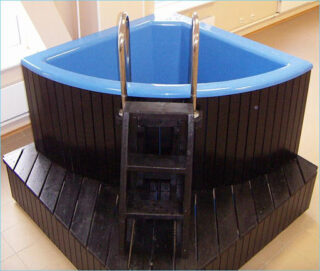
Having made the decision to build a pool in a bathhouse, you need to determine where it will be located. The main conditions for starting construction:
- the presence of a sufficient area;
- the possibility of supplying engineering communications;
- availability for maintenance.
The bowl can be equipped with:
- directly in the steam room;
- in the washing department;
- in a separate annex.
In a steam room, pools are rarely equipped. The presence of a relatively large amount of water in the steam room will disturb the steam environment (dry heat). The only thing that can justify such a decision is the organization of the entire process in one room. In this case, the size of the reservoir should be as small as possible.
In the washing section of a bath, pools are much more common. Its placement, as a rule, is laid down in the project. The dimensions of the washing room are not limited, so the reservoir can have almost any size and shape. The obligatory presence of a water supply and sewerage system in the washing compartment greatly simplifies the construction and supply of communications to the pool bowl in this room.
An extension to the bathhouse is built when it is not possible to build a pool into an existing or projected structure for some reason. This option can be implemented if you need to equip a very large pool.
Build a pool in a bath with your own hands
Before you start building a pool in a bathhouse, you need to determine the type of pool, make a project and prepare the necessary materials.
Pool types
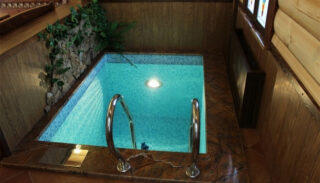
Directly in the bath you can equip:
- stationary pool;
- font;
- collapsible design;
- SPA pool.
The stationary type design is considered the most durable and strong. Structurally, it is a reinforced concrete bowl, which is installed on a foundation, equipped in a pre-dug pit.
A tub or barrel is a small-volume container (from 350 to 1500 liters) made of wood or plastic. Wooden fonts are considered classic, the material for which is larch, oak, beech.
The spa pool is a hydromassage structure designed for relaxation and relaxation. Due to its small size, it is impossible to swim in it. As a rule, they are purchased ready-made.
Collapsible pools, as a rule, serve as temporary structures. They are mobile, easy to dismantle and move to another place. They differ in a variety of shapes and sizes.
Design phase
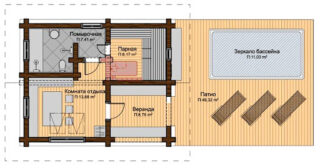
Having conceived to build a pool in a bathhouse with your own hands, you need to attend to the development of an appropriate set of technical documentation, which includes the project itself, as well as the necessary drawings and diagrams. This will allow:
- calculate all types of loads acting on the bowl;
- determine the impact of water on the soil and solve waterproofing issues (even in a small stationary pool, the amount of water is about 10 tons);
- compile a complete list of required materials, utilities and equipment;
- resolve all issues of water supply and drainage, etc.
When starting to design, you need to clearly understand the shape and size of the object. It is important to decide in advance how the construction will be carried out: in an existing building or from scratch.
Materials (edit)
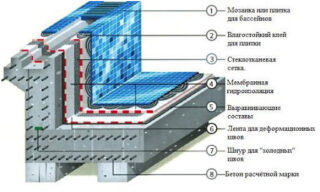
To make a swimming pool in the bath, you will need:
- cement (foundation + pool bowl);
- wood of various species (for the manufacture of formwork, steps and railings, as well as for interior decoration);
- metal fittings for the manufacture of mortgages installed in places of increased loads;
- pipes for various purposes;
- film for arranging waterproofing;
- pumps and other equipment;
- finishing materials, etc.
Pit
To build a pool in a bathhouse with your own hands, they begin with digging a pit. Its dimensions should exceed the dimensions of the designed bowl by about 0.5 m in all directions (length, width, depth). At the same time, the bottom is equipped with a slight slope, and in the deepest place a drain pipe is laid (a pipe with a diameter of 7-10 cm). From this place, a pipe is laid in the direction of a drainage pit or sewer, the distance to which should be at least 5 m.After that, a layer of sand 5 cm and a layer of crushed stone of small and medium fractions of 10 cm are poured onto the bottom and carefully compacted.
The prepared base is poured with a 10 cm layer of concrete, then a reinforcing mesh is laid on it and another 10 cm is added.
It is recommended to use concrete of a dense structure, for example, grade W-8, which is characterized by minimal moisture absorption.
Concreting and plastering walls
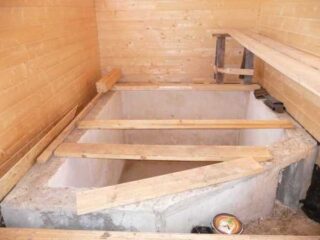
Filling the bottom with concrete, concreting of the walls begins at the same time. This process includes:
- installation of pre-prepared panel formwork;
- laying of reinforcement;
- laying concrete;
- bayonetting and tamping of concrete on the bottom and walls of the pool.
This procedure will allow you to avoid seams at the junction of the pool bottom with its walls. The bayonet of the poured concrete is carried out using a metal rod.
Further concreting of the walls is carried out in one step. Moreover, each portion of concrete must be bayonetted and carefully tamped.
After the concrete has completely hardened, which will take at least 30 days, the formwork is removed and the walls are plastered with a cement screed, the thickness of which should be 22-25 mm.
To prevent the screed from falling off the walls, it is recommended to use a waterproof composition of cement with latex, which will give the plaster additional water resistance.
Waterproofing and finishing
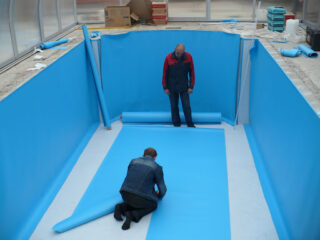
The waterproofing of the pool in the bath is done using PVC film. Its two layers are laid on the surface of the bowl, after which the film is covered from above with a layer of adhesive mixture with the addition of latex.
The decoration of the pool bowl depends on the preferences of the sauna owner. Combined methods are often used, for example: the bottom is decorated with a waterproof cement-sand screed, and the walls are tiled. Also, porcelain tiles, glass mosaics or PVC film are used for lining the pool.
Heating water
Water heating equipment is purchased in specialized stores. Heating devices include heat pumps, instantaneous electric heaters, heat exchangers, solar collectors. They are chosen based on the financial capabilities of the owner and the volume of water in the pool.
Features of installing a pool in an existing bath
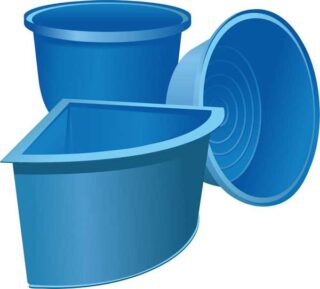
If there is a lot of space, it is better to purchase a ready-made bowl made of wood or plastic and start using it immediately after installation and connection.
You can open the floor and make a recess for the pool in place. However, in this case, it is possible to disrupt the design of the bath, which will lead to unpredictable consequences.
If there is not enough space in the bath to install the pool, it is better to build a special extension next to it, in which to equip a stationary or portable reservoir.








